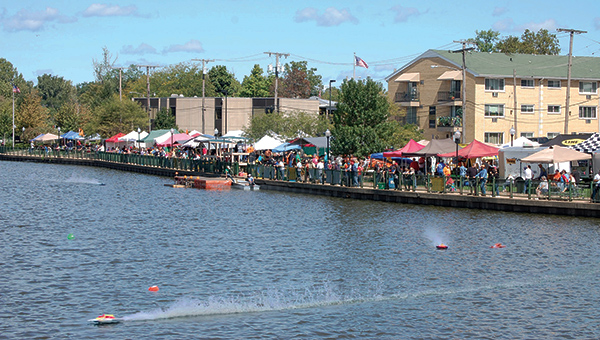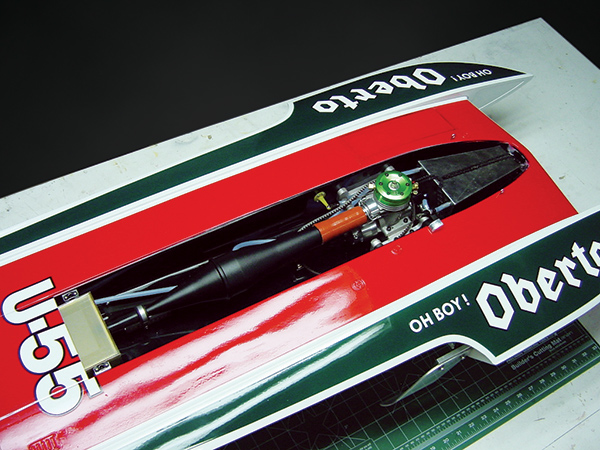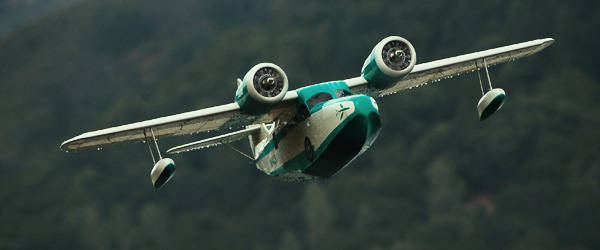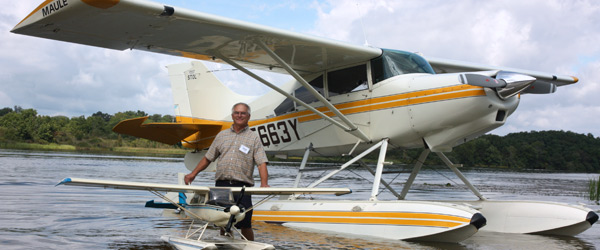“You’re on the clock.” Another RC Hobby

Written by Mike Zaborowski As featured on page 36 in the March 2013 issue of Model Aviation magazine. Also featured in the Model Aviation tablet app with bonus photos and content.
Over the microphone you hear the CD announce, “You’re on the clock!” You hear starters cranking engines and then pop ... pop ... Your motor is running at high idle and sounds perfect. This is the big championship and you’re as ready as you have ever been. As your pit man prepares to launch the boat, the clock ticks down. You drift off for a moment, thinking about how your boat has many races on it and that it has won a lot of heats. Your confidence begins to rise. The CD is calling over the microphone, “Hold your lanes!” This snaps you back to the unfolding heat. You make eye contact with your pit man and nod your head. You’re ready to go. He takes a look down the front chute to see if any boats are close or coming fast. The pit boss gives the all clear. Your pit man launches the boat flat, smooth, and on the plane. The smell of nitro fills the air. It is 30 seconds before the start, and you begin to position your boat in lane one. You’re on the clock and feeling confident. Fifteen seconds to start. You realize you are a few seconds early, so you back off the power as the other five boats back are coming on strong. You start to get edgy and your knees feel weak. You need a good start to win this heat. The competitor on your outside is a seven-time national champion. You need to win this heat to take home first place in the class!
 A view of the pit line and launch area at the Hobart Clocktower Regatta.
A view of the pit line and launch area at the Hobart Clocktower Regatta.
 On deck readying in the "Hot pits" for the next heat.
On deck readying in the "Hot pits" for the next heat.
 The winner of the daily raffle received a new, ready-to-run boat at the Clocktower Regatta.
The winner of the daily raffle received a new, ready-to-run boat at the Clocktower Regatta.
Four … three … two … one … You hear the horn. The race is on and you’re at full power. You begin to question your decision to stay in lane one, because you know you cannot go into corners one and two wide open. You lift off the power as you enter the corner! You read the water looking for holes, swells, and wake. The boat to your outside is carrying a ton of speed and is at full throttle. The turn fin on your boat strains to hold the boat in the corner. As the boats exit corners one and two you are at full power and all that you can see are huge rooster tails of water. You hear the CD call, “Dead boat!” You look to see where the dead boat is. It’s your friend and you feel bad, but you have to get your mind back into the race. Your boat, now halfway down the back chute, is running more than 70 mph. You’re in the lead as you come around corners three and four for the first lap. Five laps to go. How does it end? Who wins? Let’s learn more about the exciting hobby of RC boat racing! The model boat hobby includes many different boat types, hull styles, and power systems. RC boat racing is one of the fastest and most exciting aspects of RC boating. If you have seen an RC boat race, you probably noticed that our boats race in the opposite direction of full-scale racing. Before the radio control in RC boating came to be, our hobby was based around tether boats. Most tether boats were powered by converted ignition engines or handmade master pieces by master machinists. These engines were designed to operate counterclockwise. Model boating adopted these standards and, as the hobby grew, propellers were cast to accommodate this design. Model boating had many good propellers from which to choose. As the hobby grew, it was natural to use existing propellers and take advantage of the torque the propeller places on the hull. Because of this, RC boats turn to the right better, and we have maintained that style. Additional bonus photos from the feature
Boat types and classes that you might see at a typical RC boat race vary widely. Like aeromodelers, model boaters also use the A, B, C method of class identification. We also race electric- and gasoline-powered boats and the classes have adopted those standards. Our class identification starts with A and ends with T, skipping a few in between.
We have different hull styles including mono hulls, tunnel hulls, hydroplanes, sport hydroplanes, and catamarans. In this structure one might race a B Class tunnel hull, an E Class hydroplane, or P Class sport hydroplane. Depending on the hull style as well as the engine or power system, heat race lap speeds can reach as high as 85 mph, with speeds well past 100 mph in the straightaways..
Preparing your boat for a race takes time and dedication, but that is a large part of the fun. RC boat racing is as much a tuner’s game as it is matching driving skills on the water.
Tuning your setup requires time at a test pond, adjusting the hardware and learning to tune the motor, pipe, and propeller. Hardware includes the rudder, strut, and turn fins or trim plates. Getting the boat to ride smoothly, fast, and stable is not only a rewarding accomplishment, but also offers you your best chance to win.
Races consist of six laps on a 1/3-mile oval course, making the heat race 2 miles in length. A typical race has six boats per heat but seven- and eight-boat heats are not uncommon. The course is laid out in an oval pattern using buoys, with the length of the front and back chutes 330 feet long. The corners are typically a 35-foot radius.
Cutting inside the course is not allowed anytime the boats are on the water. Doing so draws a 50-point penalty for each buoy you cut. Cutting the entire end of the course draws a one-lap penalty.
Boats race around the course in a clockwise oval rotation. As the race begins, drivers are required to maintain a racing lane if another boat is within close proximity. Lane one is the closest lane to the center of the course and is typically the width of a boat.
Passing can be tricky. As a rule of thumb, one has to leave three boat lengths before moving into another lane. You need to consider the rooster tail and wake of the boat you are about to pass, as well those of your own, as you make your pass. If you get too close and cause the boat you just passed to blow off or crash, you can be disqualified from the heat. As you prepare to pass, you want to make sure to stay clear of the other boat’s rooster tail and wake.
Many strategies play out before and during the race. In RC boat racing, the race can be won or lost before the boats even hit the water.
Pit time is the 2-minute period of time after the CD calls, “You’re on the clock.” This block of time is used to get your boat running and mill around the course.
Clock time follows pit time and is the last 30 seconds before the race begins. No boats are allowed to launch during clock time. If your boat is not running and on the water, you will be scored a “did not start” (DNS) and receive zero points for the heat. If you did not get your boat running, you’re out of luck. You are not allowed to rerun a heat.
 "Buckshot" Shakleford's smoking fast Jag III Twin Hydro featuring Buckdaddy modified CMB 1.01ci engines, Andy Brown Pipes, and a Futaba 4pk radio. It runs on 45% nitro.
"Buckshot" Shakleford's smoking fast Jag III Twin Hydro featuring Buckdaddy modified CMB 1.01ci engines, Andy Brown Pipes, and a Futaba 4pk radio. It runs on 45% nitro.
 The author's 1/8 scale Oh Boy Oberto.
The author's 1/8 scale Oh Boy Oberto.
 The driver is ready to rock.
The driver is ready to rock.
 Under the hood of the Oh Boy Oberto. It is a simple, but effective, setup with a CMB .67ci engine, CMB "fat belly" pipe, and Futaba 4pk radio.
Under the hood of the Oh Boy Oberto. It is a simple, but effective, setup with a CMB .67ci engine, CMB "fat belly" pipe, and Futaba 4pk radio.
At the end of clock time, the race begins. The start line is typically centered on the front straightaway. The best strategy is to be as close to the start line as possible without going over or you will be called for “jumping the start” and be in last place.
The scoring structure in RC boat racing is unique. Points are awarded per heat to each boat that at least starts the heat. If your boat does not start the heat you collect zero points.
The structure looks like this:
-
First place: 400 points
Second place: 300 points
Third place: 225 points
Fourth place: 169 points
Fifth place: 125 points
Sixth place: 96 points
Did not finish (DNF): 25 points
DNS: 0 points
After five rounds of racing, the highest possible score is 2,000 points—a perfect score!
RC boat racing has many fun aspects that other types of RC racing just don’t have. The scoring system is exciting, works well, and is unique.
The boat speeds can be high and the water hard as a rock in a crash. Each lap has new challenges with ever-changing bumps, jumps, or obstacles each lap. Heat racing takes place on the same two-dimensional plane as the other boats and each time it rains, we get a new track surface!
Competition and its results can mean many different things to people. What makes RC boat racing special is the great people! If you have a tuning question, or want to learn more about boat setup, you can count on the other racers to answer questions and help you get up to speed!
Oh yeah, the winner in that race for the championship? Just by being involved and making friends, that winner is you!
Learn More About Building Boats
AMA's Greg Hahn shares basic modeling scratch building tips using a racing boatAMA's Greg Hahn shares fiber glassing tips using his racing boat.
Similar Articles
 | The Grumman Goose Designed by Paul Kohlmann.Watch flight videos, read excerpt from the article, and order plans. |
| The Icon A5 Written by Jay Smith. Find the full feature on page 55 in the May 2012 issue. Watch a shop video and an interview with the designer |
 | The Midwest Regional Float Fly As featured on page 20 in the May 2012 issue. Read the excerpts and online exclusive content.t. |
 | Flying Without Wings View photos, a video, and read a full-length feature. You can also find the feature on page 67 in the October 2011 issue. |










2 comments
Building
RC Boats
Add new comment